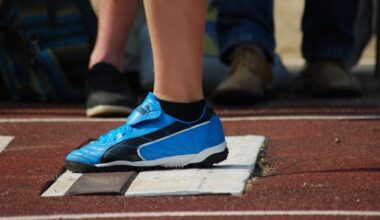Enhancing Explosive Power in Jump Events: Coaching Tips and Drills
Jump events in track and field require athletes to possess explosive power, agility, and proper technique. As a coach, it’s crucial to focus on developing athletes’ explosive strength, particularly in regards to their jumps. A well-structured training plan can significantly improve performance in events such as the long jump, high jump, and triple jump. Essential techniques include plyometric drills, resistance training, and speed work. Plyometrics such as box jumps or depth jumps can enhance fast-twitch muscle fibers, which are vital for explosive movements. Additionally, resistance training helps build strength in the legs, core, and upper body, offering a foundation for powerful jumps. Athletes should also practice proper jump techniques to maximize their potential. Integrate various types of drills into your training sessions to keep athletes motivated and engaged. Consistency and progression are keys; regularly reassess your athletes’ performance to tailor workouts effectively. Once the foundation is set, educators should instill mental strategies that encourage confidence and reduce stress during competition. Focus on building a positive, supportive environment to foster growth in your athletes during their training journey, ensuring long-term success in jump events.
When coaching jump events, understanding biomechanics is vital for enhancing performance. The principles of biomechanics help break down the mechanics of jumping into digestible parts, allowing athletes to fine-tune their techniques. Coaches should start with analyzing the approach; the speed and rhythm of an athlete’s run-up directly impact their takeoff. Emphasizing a consistent, powerful approach is essential. The takeoff phase must be executed properly, with an ideal angle of takeoff to achieve maximum distance or height. During this phase, athletes should focus on their arm movements and leg drive to optimize propulsion. After achieving peak performance, landing techniques must not be overlooked. Athletes should practice safe landing methods to minimize injury risks while ensuring they maintain balance. Implementing video analysis during training sessions can be incredibly beneficial to visualize errors and work on corrections. Mentoring athletes through detailed feedback will highlight areas needing improvement. To maintain motivation, incorporate goal-setting and personal benchmarks, enabling athletes to track progress. Use progress reports to celebrate achievements, fostering a sense of accomplishment and teamwork. Ultimately, mastering these aspects of biomechanics can lead athletes to experiences at a higher level in jump events.
Key Drills for Explosive Power Development
To build explosive power in jump events, there are numerous drills coaches can include in their training regimens. One effective drill is the broad jump; it challenges athletes to maximize their horizontal distance with explosive leg drive. Coaches should emphasize the importance of arm swing and timing while an athlete pushes through their legs. Additionally, single-leg drills can enhance stability and strength in each leg individually, ensuring balanced development. Athletes can practice single-leg hops or bounds as part of their routine. Incorporating weighted jumps, such as squat jumps or clean and press, can dramatically improve overall strength. These movements engage fast-twitch fibers in the legs and increase muscle activation. Another crucial component is speed work, where athletes perform sprints and short accelerations to enhance their fast-twitch muscle fibers. These sprints can be varied in intensity and duration to keep training sessions engaging. Coaches should also introduce agility drills, like ladder drills or cone sprints, which improve coordination and foot speed. Consistent practice of these key drills can lead to significant advancement in explosive power, crucial for jump events.
Supplementing training with proper nutrition and recovery strategies is essential for athletes. Coaches should guide athletes toward fuel sources that support intense training and fast recovery. Diets rich in protein, carbohydrates, and healthy fats ensure athletes get the performing energy they need. Nutrition recovery techniques, such as having a protein shake post-workout, help to restore and rebuild muscles. Staying properly hydrated is equally important, as it affects both performance and recovery. Athletes should also prioritize sleep, as sufficient rest is vital for muscle growth and mental health. Inadequate sleep can lead to fatigue and decreased performance. Incorporating active recovery days allows the body to recuperate while still engaging in light movements. Foam rolling and stretching practices can increase flexibility, minimize injuries, and improve overall performance. Coaches should encourage mindfulness or mental exercises to help athletes handle pressure during competitions effectively. Implementing these aspects in training routines enables athletes to perform strongly in competition settings. Ultimately, creating a comprehensive training plan that balances physical training with nutrition and recovery will produce athletes capable of exceptional performances in jump events.
Mental Preparation for Competitions
Mental preparation is often overlooked in coaching jump events, yet it plays a significant role in athlete performance. To enhance explosive power, athletes must develop mental resilience and focus alongside their physical training. As part of mental prep, visualization techniques can help athletes envision their jumps successfully. Encouraging athletes to picture themselves executing perfect jumps can significantly improve performance during actual competitions. Additionally, coaches should work on building self-confidence by setting achievable goals and celebrating milestones during training. Mental rehearsal through mock competitions helps familiarize athletes with the real competition environment, reducing anxiety during events. Strategies such as breathing exercises or positive self-talk can calm nerves and promote a favorable mindset. Encourage athletes to maintain a growth mindset; this perspective helps athletes embrace challenges and learn from failures. Performance under pressure can be heightened through practice; simulate competition scenarios during training sessions. Providing a positive environment where athletes can express vulnerability and motivate each other is also essential. Creating this supportive atmosphere allows athletes to thrive together in competitive settings, allowing them to demonstrate the full extent of their explosive power in jump events.
Evaluating performance after competition is crucial for continued development in jump events. Post-competition analysis should include reviewing video footage to assess each athlete’s jumps. Coaches must highlight the technical aspects needing improvement, such as approach speed, takeoff angle, and landing techniques. Encourage athletes to reflect on their own performances by asking guiding questions about their feelings and results during the event. Enhancing self-awareness enables athletes to identify their strengths and weaknesses. In pairs or small groups, athletes can help each other by discussing their jumps and providing feedback based on what they observed. Setting a debrief session after competitions allows coaches to address team dynamics, observe the emotional state of each athlete, and celebrate successes. This assembly solidifies lessons learned and identifies areas where adjustments could elevate performance. Work on refining technique through drills in subsequent training sessions based on gathered information. Provide specific, actionable plans that focus on individual areas for improvement, then track progress diligently. Continuous evaluation fosters a culture of growth and development, helping athletes to achieve even greater levels of explosive power in future competitions.
Conclusion: Empowering Future Athletes
Empowering athletes in track and field jump events requires a holistic approach that emphasizes explosive power development. Coaches play a crucial role in combining technical skill, mental resilience, nutrition, and recovery into an athlete’s training regimen. By integrating various drills and exercises that target explosivity, athletes can enhance performance effectively. Moreover, fostering a positive environment that encourages peer support and open conversations unlocks athletes’ potential. Be attentive to the mental and emotional aspects of training; a well-rounded perspective leads to higher confidence and better performance under pressure. Assessing performance post-competition allows both coaches and athletes to learn together, shaping future training sessions to maximize improvement. Coaching is ultimately about unlocking the potential within each athlete; it’s about providing them with the tools and knowledge to excel in their chosen events. By focusing on these aspects, coaches can contribute to developing future champions in jump events. Remember, consistency, dedication, and teamwork pave the path to success on the field. As you coach, remain committed to growth for both your athletes and for yourself, as this is the foundation of successful sports coaching.
Track and field jump events not only require physical prowess but also mental preparedness. As a coach, it is your responsibility to mentor athletes on the importance of both aspects. Introducing athletes to advanced training methods such as jump-specific plyometrics and resistance work enhances their explosive power effectively. Furthermore, focusing on key drills can yield impressive results, stemming from thorough research into biomechanical principles. Establishing a supportive and spirited training environment can foster athlete morale. Coaches should regularly check in with each athlete, providing personalized training plans tailored to individual needs. Consistency in practice while also ensuring enjoyment leads to higher engagement and motivation among athletes. Integrating a blend of heart-pumping drills with fundamentals helps instill confidence, allowing athletes to thrive successfully. Additionally, effective communication between coaches and athletes promotes transparency and trust, leading to a more harmonious training relationship. Do consider hosting workshops that focus on psychology in sports. Besides the physical, address the mental aspect. Ensure your athletes can harness their strengths through constant encouragement and training modifications. Implementation of a holistic coaching approach guarantees a lower rate of injuries and an increased likelihood of success during competitions.





